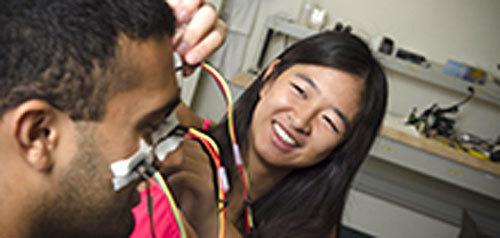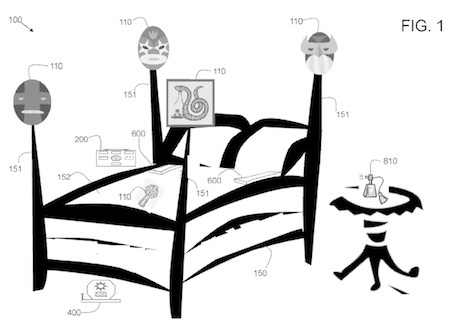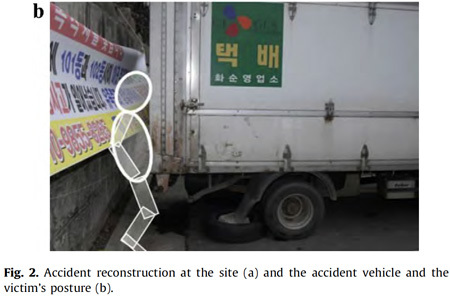Marc Abrahams's Blog, page 221
May 14, 2017
The rise of “jaw-dropping”
The phrase “jaw-dropping” has risen, with jaw-dropping suddenness, in recent times. We ran a Google Ngram data crunch. Here’s the result:
The jaw-dropping rise began in the 1980s. Here’s a look at the portion of that same graph, beginning with the 1970’s (the 1970’s itself was an era of jaw-droppingly small usage of the phrase “jaw-dropping”):
BONUS: A medical research report called “Dropped jaw—mandibular neurapraxia in the dog” was published in 1976, in the Journal of Small Animal Practice.

May 11, 2017
The Choo Lab’s Humming Generator
Many research groups across the world are in the process of developing so-called ‘Energy Harvesting’ (EH) techniques to extract electrical energy from human actions. (see for example, Implementing a knee-energy harvester).  The Choo Lab at Caltech specializes in such things, and researchers there have recently developed a system which is designed to power portable electronic devices by extracting useful energy from vibrations originating in human vocal cords. To be specific, it’s a humming generator.
The Choo Lab at Caltech specializes in such things, and researchers there have recently developed a system which is designed to power portable electronic devices by extracting useful energy from vibrations originating in human vocal cords. To be specific, it’s a humming generator.
Harvesting energy from participants who hummed* at 75dB (i.e. around normal voice levels) for 10 minutes, a test prototype was able to generate enough power to charge a battery and “operate a 10-LED array (power consumption: 2.2 V, 10 mA) […] for about a minute.” Or, put another way, enough to illuminate one LED for ten minutes. That’s to say, the device can continuously power an LED, providing its wearer keeps humming.
“Our energy harvesting method will provide a practical and efficient way to harvest energy to power portable electronics anywhere without additional charging apparatus.“
– say the team. Details are published in : ‘Powering Portable Electronics Using Vocal Fold Vibrations’, Cho, Hyunjun, Kyoo Hyun Noh, Tomohiro Ishikawa, Daejong Yang, Edgar Sanchez-Sinencio, and Hyuck Choo. IEEE MEMS, Jan 22–26, 2017, Las Vegas, NV (Oral Presentation).
*note: Also works with shouting (and, presumably, singing)
For another recent example of EH see: ‘A non-resonant, gravity-induced microtriboelectric harvester to collect kinetic energy from low-frequency jiggling movements of human limbs’ Yingxian Lu, Xiaohong Wang, Xiaoming Wu, Jin Qin and Ruochen Lu. Journal of Micromechanics and Microengineering, Volume 24, Number 6.
Also don’t miss Trumbull and Johnston’s patented tooth generator.

May 9, 2017
An invention for deterring monsters, specters, demons, and the like
“Devices and implements for deterring monsters, specters, demons, and the like,” is the title of a US patent application 13364587, Filed February 2, 2012 by Kevin M. Crucs of sparsely populated Copley, Ohio, USA. The patent document contains copious details. Among them:

“Devices and implements for staving off monsters, specters, demons and the like as imagined by a child at bedtime. A hand-held controller unit is provided having a user interface, which is capable of being used by the child under the bed covers of a bed. The hand-held controller unit may include any of a walkie-talkie capability, a flashlight capability, a nightlight capability, the capability to activate an external device, and other capabilities. At least one external device may be provided which is capable of being placed beneath the bed and is configured to be activated by the hand-held controller unit. At least one substantially hollow air-through member may be provided which is configured to facilitate airflow between underneath the bed covers of the bed and above the bed covers of the bed. A supplemental bed cover may be provided that is configured to be placed on the bed.”

May 8, 2017
Foster’s six defenses for legal obscurity
“There are many bad reasons for legal writing that is impenetrable to the layman (e.g., where writing is made impenetrable in order to necessitate recourse to lawyers which would otherwise be unnecessary, or where impenetrability is a consequence of antiquated language perpetuated purely out of sentimental conservatism).”
 – writes Charles Foster (co-recipient of the 2016 Ig Nobel Biology Prize). Nevertheless, he also alerts us to possible defenses for legal obscurity. Six in all – which are:
– writes Charles Foster (co-recipient of the 2016 Ig Nobel Biology Prize). Nevertheless, he also alerts us to possible defenses for legal obscurity. Six in all – which are:
▪ IT CAN CONVEY MEANING SUCCINCTLY
▪ IT ENABLES NUANCED REGULATION OF COMPLEX SOCIETIES
▪ IT CAN HELP TO CONVEY MEANING ACCURATELY, AND THUS AVOID LITIGATION
▪ IT CAN ENCOURAGE LAY PEOPLE TO TAKE LEGAL ADVICE IN CIRCUMSTANCES WHERE THAT IS BENEFICIAL
▪ IT ENCOURAGES EFFICIENT COMMUNICATION BETWEEN LAWYERS
▪ IT EMPHASIZES THE AUTHORITY AND OBJECTIVITY OF THE LAW
See: ‘In Defense of Legal Obscurity’ published in the journal AJOB Neuroscience, volume 8, 2017, Pages: 39-41.
For another view on language clarity (or otherwise) see ‘Say no to unclear language, don’t believe the hype’ by Anu Vallinkoski, as featured in the Journal of the University of Helsinki, 24.2.2017.

May 5, 2017
Obsessing about light, in a song
If you obsess about light, as many obsessive people do, and as many people who are fascinated by light do, and if you are prone to break into song and then explain without singing what you have just sung about, you might find yourself singing a song such as Sabine Hossenfelder sings here, and then explaining it, as Hossenfelder does after singing the song:
If, on the other hand, you feel yourself incapable of singing, and your obsession lies elsewhere than with the physics of light, you might find yourself reciting a poem, with goopy musical accompaniment, as Russ Roberts does here about the societal systematics of a loaf of bread:
(Thanks to Vaughn Tan for bringing the societal systematics of a loaf of bread to our attention.)

May 4, 2017
A novel source of ultrahigh surface area carbons – fizzy drinks (study)
“Ultrahigh surface area carbons (USACs, e.g., >2000 m2/g) are attracting tremendous attention due to their outstanding performance in energy-related applications.”
Observations such as this have lead to the search for an easy and cheap method of producing these materials – which find uses like supercapacitor electrodes, catalyst supports, and gas sorbents etc etc. A research team from Oak Ridge National Laboratory, and the University of Tennessee, (Pengfei Zhang, Zhiyong Zhang, Jihua Chen and Sheng Dai) have, between them, developed just such a method. Their study, describing the process in detail, is published in the specialist journal Carbon, Volume 93, November 2015, Pages 39–47, and is entitled ‘Ultrahigh surface area carbon from carbonated beverages: Combining self-templating process and in situ activation’
Their study, describing the process in detail, is published in the specialist journal Carbon, Volume 93, November 2015, Pages 39–47, and is entitled ‘Ultrahigh surface area carbon from carbonated beverages: Combining self-templating process and in situ activation’
“This promising process provides an exceptional route to highly porous carbon materials.”
– say the team, noting that Coca Cola®, Pepsi Cola®, Dr. Pepper®, and Fanta® all perform rather well.
The paper may be found in full here
Note that the 2009 Ig Nobel Chemistry prize was awarded to Javier Morales, Miguel Apátiga, and Victor M. Castaño of Universidad Nacional Autónoma de México, for creating diamonds from liquid — specifically from tequila.
REFERENCE: “Growth of Diamond Films from Tequila,” Javier Morales, Miguel Apatiga and Victor M. Castano, 2008, arXiv:0806.1485. Also published as Reviews on Advanced Materials Science, vol. 22, no. 1, 2009, pp. 134-8.

May 3, 2017
Medical-journals mystery? What about those parking-gate injuries?
Why are there so very few medical journal reports about parking-gate injuries?
Such injuries — which happen when a parking lot gate encounters a human body — are reported to be frequent and expensive. Yet PubMed, the preeminent database of medical studies and other medical reports, seems to include almost no medical reports about this kind of injury. Why? Have we been negligent in our search attempts? Are these kinds of injuries considered so very straightforward to treat that no medical professionals deem them worth writing about?
This video claims to show one of presumably many incidents:
As to the prevalence of this kind of injury, the trade news source Parking Today reported, in 2011: “Gate-arm accidents are responsible for 5% of all reported personal injury claims occurring in parking garages, says a study conducted by the International Parking Institute. They also present the third-highest average dollar amount, at $2,800 per claim.”
The mystery of why there are so few medical journal reports extends, too, to the question of injuries incurred when an automobile driver has physically unhappy intercourse with a parking lot automatic-ticket-payment-collection machine.

May 2, 2017
Is a Slowly-Rolling Car Not Dangerous?
Physics can help a person realize that it’s not always good to be hit by a slowly rolling car, even if the ground appears to be flat. This medical report gives details:
“Pedestrian accident analysis with a silicone dummy block,” Youngnae Lee, Sungji Park, Seokhyun Yoon, Youngsu Kong, and Jae-Mo Goh, Forensic Science International, vol. 220, no. 1, 2012, pp. e13-e16. The authors at the National Forensic Service (NFS), Seoul, South Korea, report:

A rolling car on a gentle slope seems to be easily halted by human power to prevent damage to the car or a possible accident. However, even if the car rolls down very slowly, it can cause severe injuries to a pedestrian, especially when the pedestrian cannot avoid the rolling car. In an accident case that happened in our province, a pedestrian was injured by a rolling car, which had been parked on a slope the night before. The accident occurred in the parking lot of an apartment complex. The parking lot seemed almost flat with the naked eye. We conducted a rolling test with the accident vehicle at the site. The car was made to roll down the slope by purely gravitational pull and was made to collide with the silicone block leaning against the retaining wall. Silicone has characteristics similar to those of a human body, especially with respect to stiffness. In the experiment, we measured the shock power quantitatively. The results showed that a rolling car could severely damage the chest of a pedestrian, even if it moved very slowly.

May 1, 2017
Phantom Phone Sensations (update)
 Following our earlier article regarding Phantom Phone Sensations (i.e. the sensation that one’s phone is ringing when in reality isn’t) we can now draw attention to a more recent research project from professor Robert Rosenberger of the Georgia Institute of Technology, School of Public Policy, Atlanta, US. He writes, in Computers in Human Behavior, 52 (2015) 124–131, regarding ‘An experiential account of phantom vibration syndrome’.
Following our earlier article regarding Phantom Phone Sensations (i.e. the sensation that one’s phone is ringing when in reality isn’t) we can now draw attention to a more recent research project from professor Robert Rosenberger of the Georgia Institute of Technology, School of Public Policy, Atlanta, US. He writes, in Computers in Human Behavior, 52 (2015) 124–131, regarding ‘An experiential account of phantom vibration syndrome’.
The professor’s paper explores, in some depth, what the prevalence of phantom vibration syndrome might mean for our contemporary relationships with technology – noting, however, that :
“The remarkable prevalence of phantom vibration syndrome appears to reveal something about our contemporary technological situation. But considering the scantiness of the empirical data, and considering the deep differences between the theoretical accounts of those data on offer, it is not possible to say at this time with any certainty exactly what that ‘something’ is.”
BONUS: Professor Robert Rosenberger has also written : On the hermeneutics of everyday things: or, the philosophy of fire hydrants for AI & Society (2016).

April 27, 2017
Toast and tea, in the March issue of mini-AIR
 The April issue of mini-AIR just went out. (mini-AIR is a wee little every-month supplement to the every-other-month magazine Annals of Improbable Research.)
The April issue of mini-AIR just went out. (mini-AIR is a wee little every-month supplement to the every-other-month magazine Annals of Improbable Research.)
This month it dips into:
research about TOAST and TEA.
a new research limerick contest — and the winner of last month’s Cigarette-Butt-and-Urban-Bird research limerick contest.
info about upcoming events, and events that are upcoming.
Mel [pictured here] says, “It’s swell.”
mini-AIR is the simplest way to keep informed about Improbable and Ig Nobel news and events.
Want mini-AIR e-mailed to you every month? Just opt in!

Marc Abrahams's Blog
- Marc Abrahams's profile
- 14 followers



